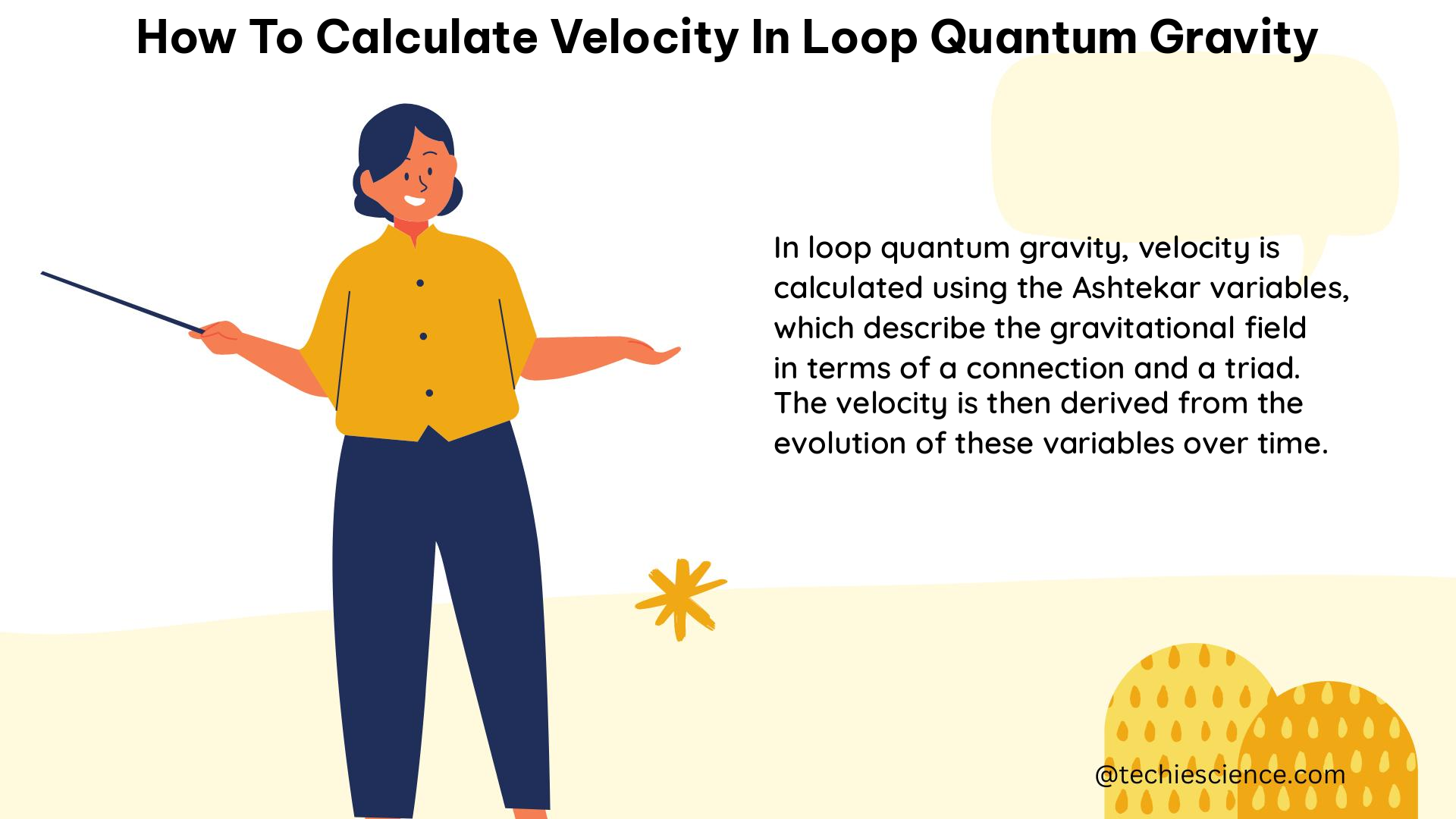Summary
Loop Quantum Gravity (LQG) is a theoretical framework that describes the discrete nature of spacetime and the quantization of geometric quantities. Calculating velocity in LQG involves understanding these fundamental concepts and applying the relevant formulas and equations. This comprehensive guide will provide you with the necessary knowledge and step-by-step instructions to calculate velocity in the context of LQG.
Discrete Spacetime in Loop Quantum Gravity

-
Spin Network: In LQG, spacetime is represented by a network of loops and nodes, known as a spin network. Each node in the spin network represents a quantum of space, and the edges between nodes represent the connections between these quanta.
-
Quantization of Geometric Quantities: LQG postulates that geometric quantities, such as the area and volume of a region in spacetime, are quantized and take on discrete values. The area of a surface in LQG is given by the following equation:
math
A-\Delta\leq 8\pi \gamma \sum_{p}{\sqrt{j_p(j_p+1)}}\leq A+\Delta
where $\gamma$ is the Immirzi parameter, $\Delta$ is a smoothing scale, and $j_p$ are half-integer quantum numbers associated with the area.
Black Hole Evaporation in Loop Quantum Gravity
-
Discrete Quanta of Energy: In LQG, the evaporation of black holes is characterized by the emission of discrete quanta of energy, which can be used to study the effects of quantum gravity.
-
Black Hole Temperature: The temperature of a black hole in LQG is given by the following equation:
math
T = \frac{1}{8\pi M}
where $M$ is the mass of the black hole.
Calculating Velocity in Loop Quantum Gravity
- Energy-Momentum Relation: In the context of black hole evaporation, the velocity of the emitted quanta can be calculated using the energy-momentum relation:
math
E^2 = p^2c^2 + m^2c^4
where $E$ is the energy, $p$ is the momentum, $c$ is the speed of light, and $m$ is the mass of the emitted quanta.
- Momentum Calculation: To calculate the momentum, we can use the following equation:
math
p = \sqrt{\frac{E^2 - m^2c^4}{c^2}}
If the mass of the quanta is negligible compared to the energy, we can approximate:
math
p \approx \frac{E}{c}
- Velocity Calculation: Finally, the velocity of the emitted quanta can be calculated using the following equation:
math
v = \frac{p}{m} = \frac{E}{mc}
Example Calculation
Let’s consider a black hole with a mass of $M = 10^5$ kg and an emitted quanta with an energy of $E = 10^{-5}$ J.
- Calculate the momentum:
math
p \approx \frac{E}{c} = \frac{10^{-5}\ \text{J}}{3 \times 10^8\ \text{m/s}} = 3.33 \times 10^{-14}\ \text{kg}\cdot\text{m/s}
- Calculate the velocity:
math
v = \frac{p}{m} = \frac{3.33 \times 10^{-14}\ \text{kg}\cdot\text{m/s}}{10^{-26}\ \text{kg}} = 3.33 \times 10^7\ \text{m/s}
Therefore, the velocity of the emitted quanta from the black hole is approximately $3.33 \times 10^7$ m/s.
Additional Considerations
-
Immirzi Parameter: The Immirzi parameter, $\gamma$, is a dimensionless constant that appears in the equations describing the quantization of geometric quantities in LQG. The value of $\gamma$ is still a subject of ongoing research and debate in the field of LQG.
-
Smoothing Scale: The smoothing scale, $\Delta$, is a parameter that accounts for the uncertainty in the measurement of the area of a surface in LQG. The value of $\Delta$ depends on the specific context and the level of precision required in the calculations.
-
Quantum Numbers: The half-integer quantum numbers, $j_p$, are associated with the area of a surface in LQG. These quantum numbers represent the discrete nature of the geometry and are fundamental to the LQG framework.
-
Limitations and Ongoing Research: It’s important to note that the calculations and formulas presented in this guide are based on the current understanding of LQG, which is an active area of research. As the field of LQG continues to evolve, the specific details and equations may be subject to refinement or revision.
References
- ResearchGate. (n.d.). Loop Quantum Gravity. Retrieved from https://www.researchgate.net/publication/290150645_Loop_quantum_gravity
- Barrau, A. (n.d.). Black Holes and Quantum Gravity. Inference Review. Retrieved from https://inference-review.com/article/black-holes-and-quantum-gravity
- Dummies. (2016, March 26). Calculate the Velocity Necessary to Counteract Gravity in a Loop. Retrieved from https://www.dummies.com/article/academics-the-arts/science/physics/calculate-the-velocity-necessary-to-counteract-gravity-in-a-loop-174073/
- Rovelli, C. (n.d.). Loop Quantum Gravity. PMC – NCBI. Retrieved from https://www.ncbi.nlm.nih.gov/pmc/articles/PMC5567241/
- Sahlmann, H. (n.d.). Coupling Matter to Loop Quantum Gravity. publish.UP. Retrieved from https://publishup.uni-potsdam.de/opus4-ubp/frontdoor/deliver/index/docId/54/file/sahlmann.pdf

The lambdageeks.com Core SME Team is a group of experienced subject matter experts from diverse scientific and technical fields including Physics, Chemistry, Technology,Electronics & Electrical Engineering, Automotive, Mechanical Engineering. Our team collaborates to create high-quality, well-researched articles on a wide range of science and technology topics for the lambdageeks.com website.
All Our Senior SME are having more than 7 Years of experience in the respective fields . They are either Working Industry Professionals or assocaited With different Universities. Refer Our Authors Page to get to know About our Core SMEs.